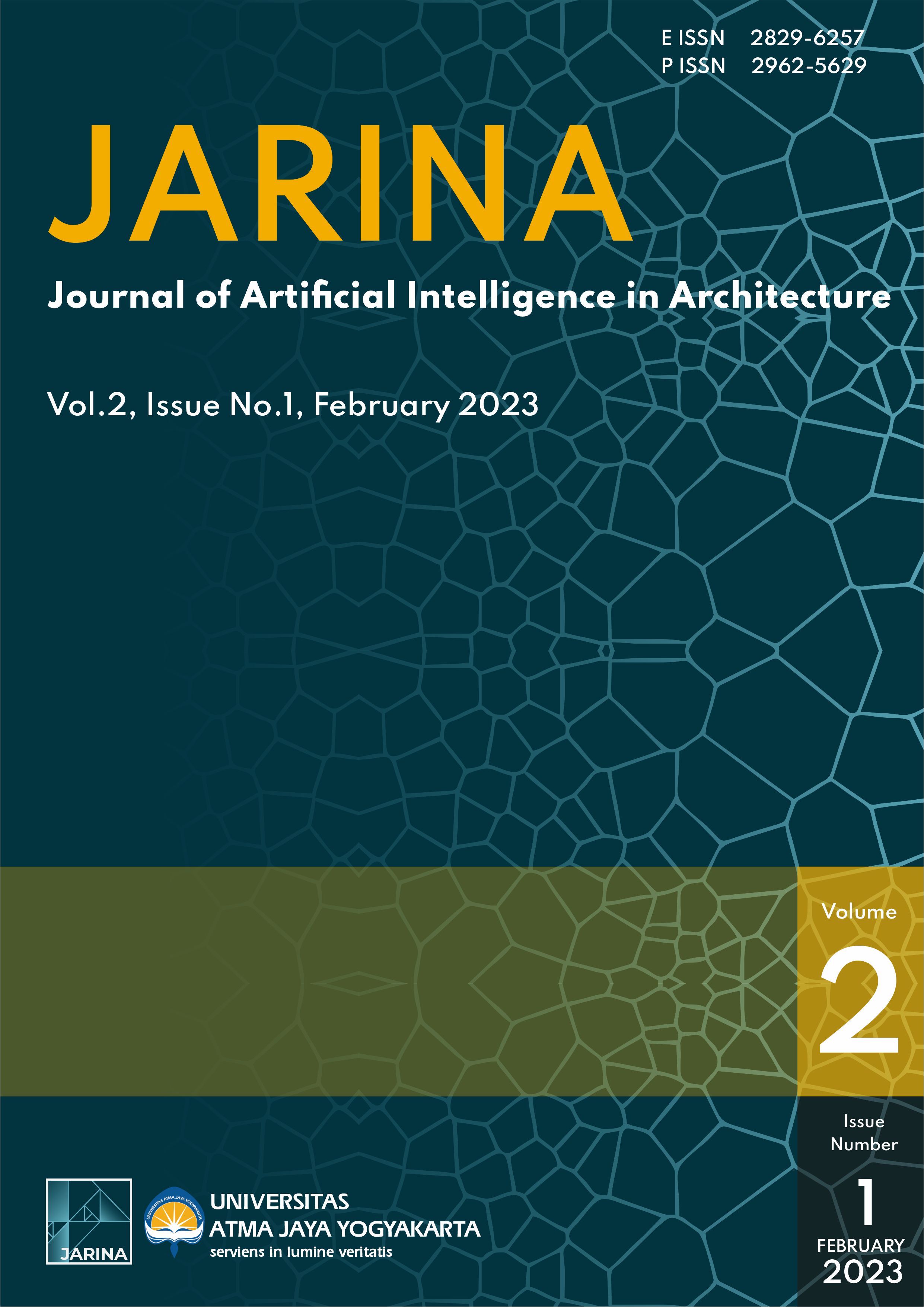An Adaptive Photovoltaic Performance Study with a Biomimetic Approach for Energy Saving
DOI:
https://doi.org/10.24002/jarina.v2i1.6331Keywords:
Adaptive Facade, Biomimetic , Parametric, OTTV, PhotovoltaicAbstract
The facade has a function to improve the energy performance of the building by controlling the acquisition of sunlight and natural lighting. The biomimetic architecture approach is one form of architecture that imitates the principles of nature—integrating photovoltaics with facades to utilize solar lighting and generate electricity for building needs. The novelty of this study aims to examine the effectiveness of adaptive facade forms with a biomimetic approach integrated with photovoltaic on heat transfer and energy saving and determine the factors that influence it. This study uses the parametric modeling simulation method. In addition, this study compares aspects of heat transfer and energy generated by photovoltaics on adaptive facades with a biomimetic approach. The study's results using a flower petal-shaped adaptive biomimetic facade showed that OTTV 35 watt/m2 (standard) obtained all grid configurations with an opening angle of 10-20 degrees, and the average electrical energy produced by integrated Photovoltaic was around 1,757.7 kWh. This result provides energy savings of 20.03% on a building.
References
T. Mols and A. Blumberga, “Inverse modelling of climate adaptive building shells. System dynamics approach,” Environ. Clim. Technol., vol. 24, no. 2, pp. 170–177, Sep. 2020.
F. Soflaei, M. Shokouhian, A. Tabadkani, H. Moslehi, and U. Berardi, “A simulation-based model for courtyard housing design based on adaptive thermal comfort,” J. Build. Eng., vol. 31, Sep. 2020.
A. Budhiyanto, Efektivitas Konfigurasi Selubung Bangunan Terintegrasi Fotovoltaik Terhadap Efisiensi Energi Simulasi Bangunan Hipotetik Perkantoran Berlantai Banyak berdasarkan Data Iklim Jakarta. 2016.
A. Kusumawanto and Z. B. Astuti, Arsitektur hijau dalam inovasi kota, Cetakan Kedua. Gadjah Mada University Press, 2017.
S. Attia, S. Bilir, T. Safy, C. Struck, R. Loonen, and F. Goia, “Current trends and future challenges in the performance assessment of adaptive façade systems,” Energy Build., vol. 179, no. February 2019, pp. 165–182, 2018.
A. N. Anantama and A. Hariyadi, “Effectiveness of adaptive facade with helicone mechanisms on energy values and natural lighting in Indonesia,” ARTEKS J. Tek. Arsit., vol. 6, no. 3, pp. 437–446, Dec. 2021.
Pemerintah Provinsi DKI Jakarta, “Panduan Pengguna Bangunan Gedung Hijau Jakarta - Vol 1 - Selubung Bangunan,” Pandu. Pengguna Bangunan Gedung Hijau Jakarta, vol. 1, no. 38, p. 40, 2016.
M. Barozzi, J. Lienhard, A. Zanelli, and C. Monticelli, “The Sustainability of Adaptive Envelopes: Developments of Kinetic Architecture,” Procedia Eng., vol. 155, pp. 275–284, 2016.
R. L. Hwang, W. M. Shih, T. P. Lin, and K. T. Huang, “Simplification and adjustment of the energy consumption indices of office building envelopes in response to climate change,” Appl. Energy, vol. 230, pp. 460–470, Nov. 2018.
Badan Standarditasi Nasional (BSN), “SNI 6389:2011, tentang Konservasi energi selubung bangunan pada bangunan gedung,” pp. 1–60, 2011.
C. P. Dewi, R.-Y. Huang, and A. M. Nugroho, “Strategi Double Skin Fasade pada Bangunan Kampus National Central University dalam Menurunkan Kebutuhan Energi Pendinginan,” Rev. Urban. Archit. Stud., vol. 11, no. 2, pp. 51–59, 2013.
B. Talarosha, “Menciptakan Kenyamanan Termal dalam Bangunan,” J. Sist. Tek. Ind., vol. 6, no. 3, pp. 148–158, 2005.
A. Atthaillah, U. Malikussaleh, and R. A. Mangkuto, “Optimisasi Parametrik Fasad Bilah Horizontal terhadap Pencahayaan Alami,” vol. 7, no. July, 2020.
M. Bielek and B. Bielek, “Envoronmental strategies for design of sustainable buildings in technique of green-ECO architecture,” Proc. CESB 2010 Prague - Cent. Eur. Towar. Sustain. Build. ’From Theory to Pract., pp. 1–7, 2010.
S. Haddad, S. King, P. Osmond, and S. Heidari, “Semi-transparent building-integrated photovoltaic windows: Potential energy savings of office buildings in tropical Singapore,” Scopus, 2012.
R. C. G. M. Loonen, M. Trčka, D. Cóstola, and J. L. M. Hensen, “Climate adaptive building shells: State-of-the-art and future challenges,” Renew. Sustain. Energy Rev., vol. 25, pp. 483–493, 2013.
V. R. M. Lo Verso, G. Mihaylov, A. Pellegrino, and F. Pellerey, “Estimation of the daylight amount and the energy demand for lighting for the early design stages: Definition of a set of mathematical models,” Energy Build., vol. 155, pp. 151–165, 2017.
Z. Nagy et al., “The Adaptive Solar Facade: From concept to prototypes,” Front. Archit. Res., vol. 5, no. 2, pp. 143–156, 2016.
M. A. Nessim, “Biomimetic architecture as a new aproach for energy efficient buildings through smart building materials,” J. Green Build., vol. 10, no. 4, pp. 73–86, 2015.
“What is Biomimetic Architecture and why young Architects should know about it - RTF | Rethinking The Future.” [Online]. Available: https://www.re-thinkingthefuture.com/rtf-fresh-perspectives/a539-what-is-biomimetic-architecture-and-why-young-architects-should-know-about-it/. [Accessed: 06-Sep-2022].
H. Kim and M. J. Clayton, “A multi-objective optimization approach for climate-adaptive building envelope design using parametric behavior maps,” Build. Environ., vol. 185, p. 107292, Nov. 2020.
M. H. dan H. A. M. R. Indonesia, “Kepmenkumham No : M.HH-01.PL.01.01 Tahun 2016 Tentang Standarisasi Ruang Kantor dan Sarana Prasarana Kantor di Lingkungan Kementrian Hukum Dan Hak Asasi Manusia.” 2016.
E. Neufert, Neufert Architects’ Data, vol. 53, no. 9. 1980.
C. Bedon et al., “Structural characterisation of adaptive facades in Europe – Part I: Insight on classification rules, performance metrics and design methods,” J. Build. Eng., vol. 25, no. February, 2019.
N. Guimarães, A. Paio, S. Oliveira, F. Osório, and M. J. Oliveira, Architecture in-play International Conferences Proceedings. 2016.
D. Dissertation and A. Hariyadi, “Study of Parametric ‘ Sudare ’ Façade for Optimization of Visibility and Energy Efficient Building in Jakarta Indonesia,” no. June, 2017.

Downloads
Published
How to Cite
Issue
Section
License
Copyright (c) 2023 Kevin Ananda, Agus Hariyadi

This work is licensed under a Creative Commons Attribution 4.0 International License.
Authors who publish with this journal agree to the following terms:
1.Authors retain copyright and grant the journal right of first publication with the work simultaneously licensed under a Creative Commons that allows others to share the work with an acknowledgement of the work's authorship and initial publication in this journal.
2.Authors are able to enter into separate, additional contractual arrangements for the non-exclusive distribution of the journal's published version of the work (e.g., post it to an institutional repository or publish it in a book), with an acknowledgement of its initial publication in this journal.
3.Authors are permitted and encouraged to post their work online (e.g., in institutional repositories or on their website) prior to and during the submission process, as it can lead to productive exchanges, as well as earlier and greater citation of published work (See The Effect of Open Access).
















